Pocket K No. 61: Rust Resistant Soy for Africa
| |
Soybean: Gold from the Soil
Soybean is a highly versatile crop that has strong economic value due to its climate tolerance, protein and oil content, and its ability to improve soil nitrogen.1 It also commands a higher price than other staple crops, making it a cash crop for many smallholder farmers.
Because of its many benefits, soybean has been called “Gold from the soil” and has been widely grown in North and South America. However, the greatest expansion of soybean cultivation today is happening in Africa.2
Rising Demand for Soybean
Soybean demand across Sub-Saharan Africa is projected to more than double by 2050.3 Despite this surge in demand, Africa contributes a meager 1% of the global soybean production, leading to a heavy dependence on costly imports to fill the demand gap. In 2019, Africa spent $43 billion in food imports, including $2 billion for soybean. By 2021, soybean imports exceeded $3 billion, a 55% increase in just two years.4
Increasing Domestic Production
To reduce costly imports and bolster local economies, many African countries have sought to increase their domestic soybean production. Kenya is one of the countries in the region that has acknowledged the value of increased soybean production5 and has taken steps to create policies promoting agricultural innovation.6 With soybean promising a higher price than other staple crops, smallholder farmers have increasingly embraced greater production.7
An Emerging Threat: Asian Soybean Rust
As the nascent African soybean industry expands, a significant threat has emerged: destruction of the crop by Asian soybean rust (ASR). Caused by the airborne fungus, Phakopsora pachyrhizi, it is a fast-moving, aggressive disease that can destroy up to 90% of a soybean crop within just 3 weeks of initial infection. It is already the leading cause of yield loss in Africa.
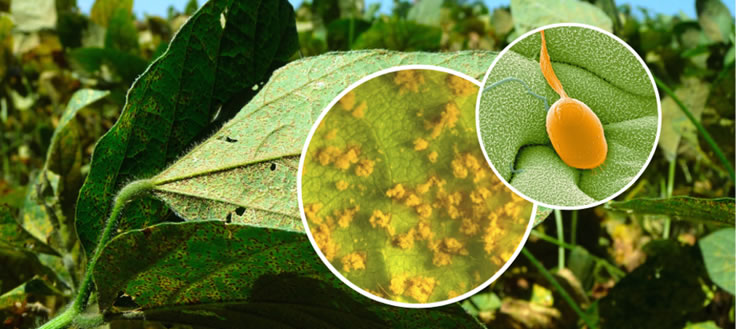
Searching for Solutions: Crop Protection
Fungicides have been effective in controlling ASR, but they are expensive (exceeding $2 Billion USD in Brazil alone)8 and pose potential impacts on human health and the environment. Most critically, the pathogen is rapidly adapting and building tolerance to these chemical controls, rendering them less effective.9
Searching for Solutions: Breeding
In addition to chemical controls, scientists have searched for sources of resistance within soybean for breeding purposes. Though seven (7) such genes are known in the soybean genome, they are found across different varieties and have been largely overcome bythe pathogen. Breeders are trying to produce resistant varieties, but this approach is time-consuming and may prove inadequate.
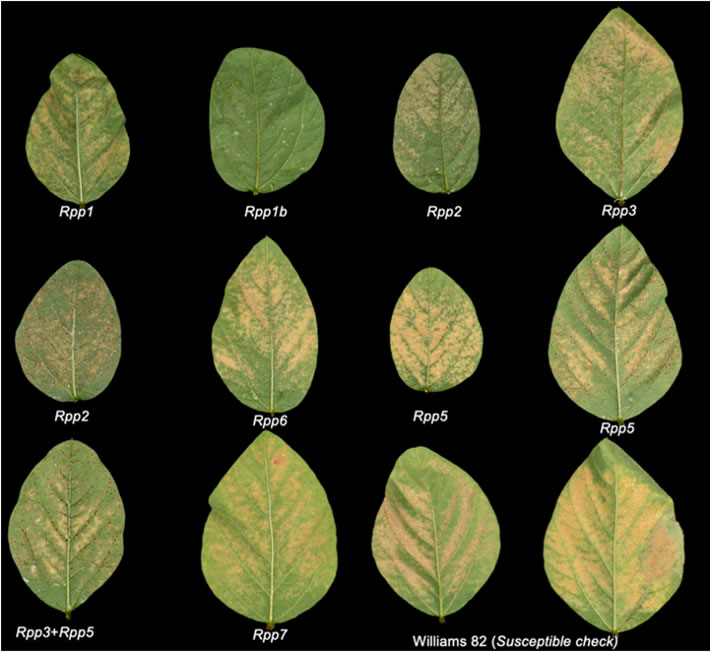
Searching for Solutions: Screening Global Soy Varieties
Experts from the Soybean Innovation Lab (SIL) of the US Agency for International Development (USAID) conducted extensive field trials in 120 locations in 24 countries to identify the highest-performing soybean varieties for different African agro-ecological zones.10 SIL has also monitored the susceptibility of entries in the trials to ASR. Although a few lines showed somelevel of tolerance against ASR, none exhibit robust resistance.11
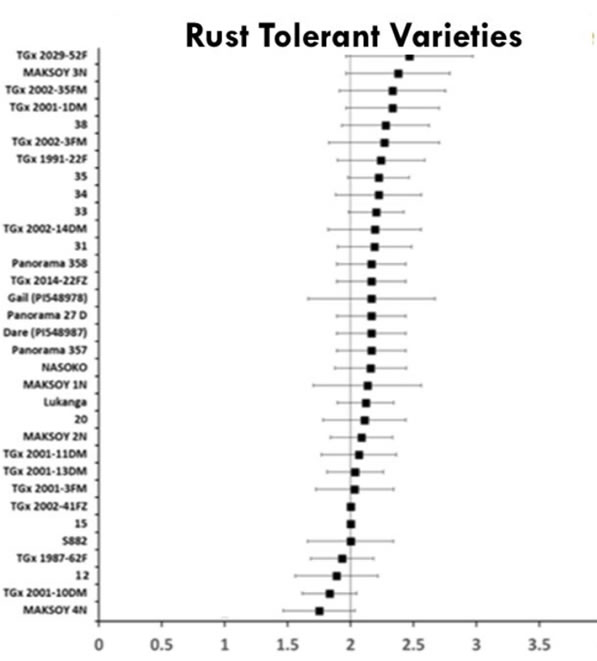
Searching for Solutions: Calling on Relatives
In search of more effective measures, 2Blades and its partners have explored a broader pool of resistance genes among related legume species to identify novel sources of genetic resistance to ASR. One successful proof-of-principle was the transfer of a pigeonpea gene into soy to achieve strong resistance to ASR.12
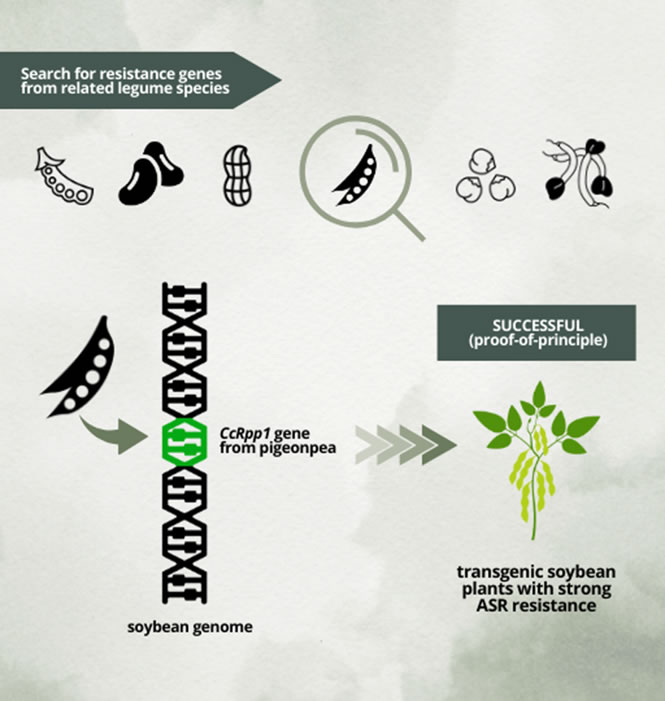
Pigeonpea Answers the Call
Pigeonpea is a legume crop that is closely related to soybean. It is a valuable source of protein and other nutrients for people and livestock in many parts of the world.
The gene, CcRpp1, was identified in a pigeonpea accession that was resistant to a wide range of ASR isolates. When CcRpp1 was introduced into soybean through biotechnology, the plants exhibited strong resistance to ASR.13 This finding paves the way to develop soybean varieties that are resistant to ASR without impacting the plant’s growth and development.
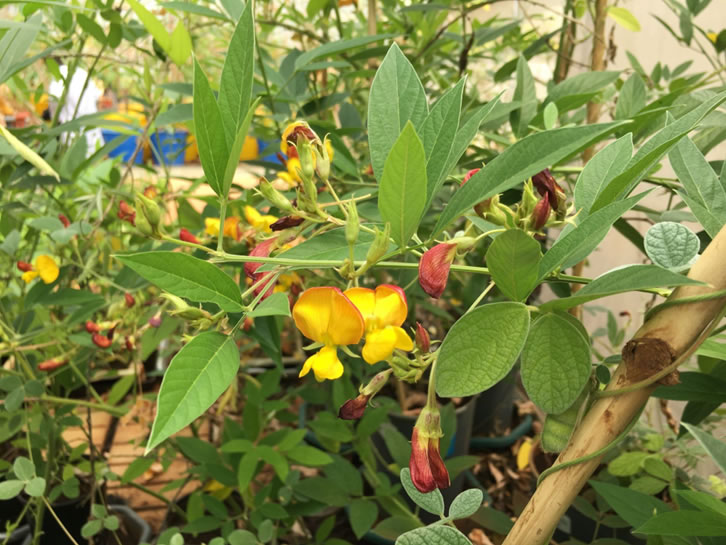
Benefits of a Biotech Approach
Developing resistance through a biotech approach is one of the most durable and effective ways to thwart diseases like ASR because:
- Crop relatives can be sourced for a broader pool of functional resistance genes that pathogens are less likely to have been exposed to and/or overcome.
- Genes can be introduced into high-performing varieties favored by farmers, preserving preferred traits and selectively adding protection to ASR without linkage drag.
- Genes with different modes of action can be stacked together to achieve greater durability of resistance and simplicity in breeding.
- Farmers can significantly reduce or even eliminate the need for chemical sprays.
Delivery Depends on Effective Partnerships
To achieve the goal of delivering ASR-resistant soybeans for African growers, strong and effective partnerships are needed throughout the agriculture innovation chain. Each link makes up a key component to achieving impact.
Why it Matters
Stakeholder groups will experience direct and indirect benefits of ASR-resistant soybeans:
- Farmers will experience improved yields, less exposure to chemical sprays, and increased income to support their families.
- Researchers will gain more knowledge and understanding of soybean diseases and pests.
- Seed companies will gain an improved product pipeline and market share.
- Policymakers will gain knowledge to make informed decisions for future planning and policies.
- The livestock and aquaculture industry can rely less on soybean imports; stabilizing the local supply chain.
- Consumers will have access to more soybeans, a rich source of protein and nutrition.
Why it Matters
Successful development and deployment of ASR-resistant tropical soybean will be a major steptowards strengthening domestic production in Kenya and the region. It will promote economicdiversification, enrich the soil, reduce chemical use, introduce new high-value products and markets derived from soy, and enhance soy profitability for farmers, producers, and processors.
References
- 2Blades Foundation. (2023, February 13). 2Blades’ AIM4C Panel Discussion on Ag Innovation - COP27 event [Video]. YouTube. https://www.youtube.com/watch?v=YPLvU6sthE8&t=1405s.
- Dies, E. J. (1942). Soybeans: Gold from the Soil. Macmillan, New York.
- Gbegbelegbe, S., Alene, A., Kamara, A., Wiebe, K., Manyong, V., Abdoulaye, T., & Mkandawire, P. (2019). Ex‐ante evaluation of promising soybean innovations for sub‐Saharan Africa. Food and energy security, 8(4), e00172. https://www.ncbi.nlm.nih.gov/pmc/articles/PMC7043309/.
- Food and Agriculture Organization of United States. (n.d.). Food and Agriculture Data. Retrieved from http://www.fao.org/faostat.
- Ngotho, A. (2023). Relief for feed makers as Treasury announces duty-free imports. The Star. Retrieved from https://www.the-star.co.ke/counties/rift-valley/2023-06-20-relief-for-feed-makers-astreasury-announces-duty-free-imports/.
- Reuters. (2022). Kenya lifts ban on genetically modified crops in response to drought. Retrieved from https://www.reuters.com/world/africa/kenya-lifts-ban-genetically-modified-cropsresponse-drought-2022-10-04/.
- CIMMYT. (2024). Soybean rust threatens soybean production in Malawi and Zambia. Retrieved from https://www.cimmyt.org/news/soybean-rust-threatens-soybean-production-in-malawiand-zambia/.
- Godoy, C. V., Seixas, C. D. S., Soares, R. M., Marcelino-Guimarães, F. C., Meyer, M. C., & Costamilan, L. M. (2016). Asian soybean rust in Brazil: past, present, and future. Pesquisa Agropecuária Brasileira, 51, 407-421.
- Mayer, M. C. (2023). Effectiveness of fungicides against P. pachyrhizi over time in Brazil [Conference Poster].
- Soybean Innovation Lab. (n.d.). Pan-African Soybean Variety Trials (PAT). Feed the Future. Retrieved from https://soybeaninnovationlab.illinois.edu/seed.
- Soybean Innovation lab. (n.d.). Disease and Pest Team Rust Update #1. Feed the Future. https://7b7dcda8-7264-4c41-b9a2-b2e845d0c5d1.usrfiles.com/ugd/7b7dcd_73da13c006da4f36b7bc1592fa7dad72.pdf
- 2Blades (2022). 2Blades and Corteva Agriscience Reach Collaboration Milestone in Development of Durable Resistance for Latin American Soybean Varieties. 2Blades. Retrieved from https://2blades.org/2022/07/20/2blades-and-corteva-agrisciencereach-collaboration-milestone-in-development-of-durableresistance-for-latin-american-soybean-varieties/.
- Kawashima, C. G., Guimarães, G. A., Nogueira, S. R., MacLean, D., Cook, D. R., Steuernagel, B., ... & Brommonschenkel, S. H. (2016). A pigeonpea gene confers resistance to Asian soybean rust in soybean. Nature Biotechnology, 34(6), 661-665.
